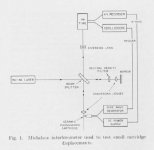A Michelson Interferometer for Use in Measuring Characteristics of Phonograph Cartridges
H. J. Gerritsen, W. W. Millbrandt, and R. L. Omegna »View Author Affiliations
Applied Optics, Vol. 9, Issue 5, pp. 1231-1232 (1970)
Optics InfoBase: Applied Optics - A Michelson Interferometer for Use in Measuring Characteristics of Phonograph Cartridges
H. J. Gerritsen, W. W. Millbrandt, and R. L. Omegna »View Author Affiliations
Applied Optics, Vol. 9, Issue 5, pp. 1231-1232 (1970)
Optics InfoBase: Applied Optics - A Michelson Interferometer for Use in Measuring Characteristics of Phonograph Cartridges
Bruel @ Kjaer seems to make measurements with the accellerometer in 1976 must have the article somewhere.
View attachment 458034
The article is interesting but they use a bare calibrated piezo-accelerometer which they make ($$$) and which is reciprocal. They also show leaving out the vinyl damping makes for very different answers from a test LP.
Bad news for the vinyl and the stylus, if the vinyl has to dampen spurious resonances.They also show leaving out the vinyl damping makes for very different answers from a test LP.
So, as I suspected, the only way to determine the frequency response of a cartridge when playing an LP is to measure it while it is playing an LP. The problem becomes one of making well calibrated test LPs.
Muraoka was one of the developers of CD4 -- he used an impulse train and FFT to derive the amplitude and group delay of phono cartridge.
This was 1974. He had an LP cut with an impulse, then performed the FFT on the pulse train. Perhaps the same could be done with a piezo actuator.
In a later paper for the AES (2009) he cut radiating grooves from the center of an old 78RPM record to work backwards the response of the Victrola Credenza.
Muraoka was one of the developers of CD4 -- he used an impulse train and FFT to derive the amplitude and group delay of phono cartridge.
This was 1974. He had an LP cut with an impulse, then performed the FFT on the pulse train. Perhaps the same could be done with a piezo actuator.
I can't get the AES papers for free, but I was curious about any issues with the "impulse" geometry and its relation to the stylus shape. I would think sorting through a scratchy LP lead-in lead-out might even yield enough to average some data out of it. I certainly have observed a nearly uniform shape of small ticks.
The point in the B&K article is that the vinyl groove has to be there or the answer is off. Maybe glue a piece of an LP to the middle? BTW I don't get their conclusion that accelerometer testing is superior because it eliminates the effects of the record being there.
Last edited:
Hi,
Tip shape means no static test can ever be accurate at high frequencies.
A groove must be involved. Unless your just testing consistency
of everything else other than the actual tip profile.
rgds, sreten.
My concern was that the process of tracking a groove at high frequencies had enough non-linearity and level dependence that impulse testing had its own inaccuracies sort of like testing speakers with 1000V 1us pulses. I was just curious about the comparison of impulse and continuous tone testing.
A Michelson Interferometer for Use in Measuring Characteristics of Phonograph Cartridges
They had the article in the library at wife's university -- I sold my last photomultiplier tube about 8 years ago:
Attachments
Thank's got the papers. Interesting though definitely not DIY. I need to read more carefully the role of the ultra-low speed metal version of the impulses used as a reference since I don't see exactly why eliminating the vinyl compliance is useful (also destructive eventually?).
I did like the article on the 78's with the hand made scratches on an unused record, I can do that.
Where's the LP in the above? As shown looks like a measurement of reciprocity in the ceramic cart.
I did like the article on the 78's with the hand made scratches on an unused record, I can do that.
Where's the LP in the above? As shown looks like a measurement of reciprocity in the ceramic cart.
Last edited:
Where's the LP in the above? As shown looks like a measurement of reciprocity in the ceramic cart.
They were using a ceramic cartridge to measure some bio-physical data. Reminds me of one of the neighborhood kids who used a pair of phono-cartridges as a DIY seismometer for science fair -- cheaper than Guralp.
The 1978 Stereo Review test record has a series of repeated gun shot blasts on the last track of side 2 -- or you could take the FFT of the repeated 500Hz square wave and work back from the attenuation of the value of the harmonics. Slow the record from 33RPM and le voila.
- Status
- This old topic is closed. If you want to reopen this topic, contact a moderator using the "Report Post" button.
- Home
- Source & Line
- Analogue Source
- Phono cartridge measuring idea
